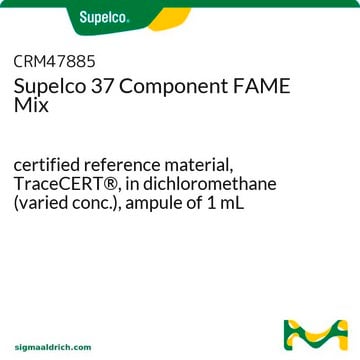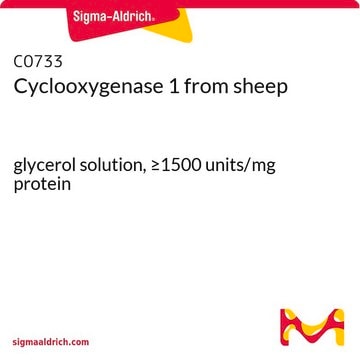Products may be shipped at a different temperature than the recommended long-term storage temperature. If the product quality is sensitive to short-term exposure to conditions other than the recommended long-term storage, it will be shipped on wet or dry-ice. If the product quality is NOT affected by short-term exposure to conditions other than the recommended long-term storage, it will be shipped at ambient temperature. As shipping routes are configured for minimum transit times, shipping at ambient temperature helps control shipping costs for our customers. For more information, please refer to the Storage and Transport Conditions document: https://www.sigmaaldrich.com/deepweb/assets/sigmaaldrich/marketing/global/documents/316/622/storage-transport-conditions-mk.pdf
Wichtige Dokumente
A3611
Arachidonsäure
from non-animal source, ≥98.5% (GC)
Synonym(e):
cis,cis,cis,cis-5,8,11,14-Eicosatetraensäure, Immunocytophyt
Größe auswählen
Größe auswählen
About This Item
Empfohlene Produkte
Biologische Quelle
non-animal source
Qualitätsniveau
Assay
≥98.5% (GC)
Form
liquid
Brechungsindex
n20/D 1.4872 (lit.)
bp
169-171 °C/0.15 mmHg (lit.)
mp (Schmelzpunkt)
−49 °C (lit.)
Dichte
0.922 g/mL at 25 °C (lit.)
Funktionelle Gruppe
carboxylic acid
Lipid-Typ
omega FAs
Versandbedingung
dry ice
Lagertemp.
−20°C
SMILES String
OC(CCC/C=C\C/C=C\C/C=C\C/C=C\CCCCC)=O
InChI
1S/C20H32O2/c1-2-3-4-5-6-7-8-9-10-11-12-13-14-15-16-17-18-19-20(21)22/h6-7,9-10,12-13,15-16H,2-5,8,11,14,17-19H2,1H3,(H,21,22)/b7-6-,10-9-,13-12-,16-15-
InChIKey
YZXBAPSDXZZRGB-DOFZRALJSA-N
Suchen Sie nach ähnlichen Produkten? Aufrufen Leitfaden zum Produktvergleich
Verwandte Kategorien
Anwendung
<li><strong>Molecular Mechanisms Associated with the Inhibitory Role of Long Chain n-3 PUFA in Colorectal Cancer:</strong> In dieser Studie werden die Auswirkungen langkettiger mehrfach ungesättigter Fettsäuren wie Arachidonsäure auf die Mechanismen von Darmkrebs untersucht. Die Forschung konzentriert sich auf die entzündungshemmende und krebshemmende Rolle durch die Modulation des Lipidstoffwechsels und der Signaltransduktionskanäle (Jayathilake et al., 2024).</li>
<li><strong>Zhilining Formula alleviates DSS-induced colitis through suppressing inflammation and gut barrier dysfunction via the AHR/NF-Bp65 axis:</strong> In diesem Artikel wird die Rolle der Arachidonsäure bei der Unterdrückung von Entzündungen und der Wiederherstellung der Barrierefunktion des Darms vorgestellt, die für das Verständnis von Entzündungskrankheiten und die Entwicklung therapeutischer Strategien von entscheidender Bedeutung ist (Zhou et al., 2024).</li>
<li><strong>5,6-diHETE lactone (EPA-L) mediates hypertensive microvascular dilation by activating the endothelial GPR-PLC-IP(3) signaling pathway:</strong> Untersucht die kardiovaskulären Auswirkungen von Arachidonsäure-Metaboliten, insbesondere ihre Rolle bei mikrovaskulären Reaktionen, die sich auf die Behandlungsstrategien bei Hypertonie auswirken könnten (Asulin et al., 2024).</li>
</ul>
Biochem./physiol. Wirkung
Verpackung
Signalwort
Warning
H-Sätze
Gefahreneinstufungen
Eye Irrit. 2 - Skin Irrit. 2
Lagerklassenschlüssel
10 - Combustible liquids
WGK
WGK 3
Flammpunkt (°F)
235.4 °F - closed cup
Flammpunkt (°C)
113 °C - closed cup
Hier finden Sie alle aktuellen Versionen:
Analysenzertifikate (COA)
Die passende Version wird nicht angezeigt?
Wenn Sie eine bestimmte Version benötigen, können Sie anhand der Lot- oder Chargennummer nach einem spezifischen Zertifikat suchen.
Besitzen Sie dieses Produkt bereits?
In der Dokumentenbibliothek finden Sie die Dokumentation zu den Produkten, die Sie kürzlich erworben haben.
Kunden haben sich ebenfalls angesehen
-
How is shipping temperature determined? And how is it related to the product storage temperature?
1 answer-
Helpful?
-
-
How can I determine the shelf life / expiration / retest date of this product?
1 answer-
If this product has an expiration or retest date, it will be shown on the Certificate of Analysis (COA, CofA). If there is no retest or expiration date listed on the product's COA, we do not have suitable stability data to determine a shelf life. For these products, the only date on the COA will be the release date; a retest, expiration, or use-by-date will not be displayed.
For all products, we recommend handling per defined conditions as printed in our product literature and website product descriptions. We recommend that products should be routinely inspected by customers to ensure they perform as expected.
For products without retest or expiration dates, our standard warranty of 1 year from the date of shipment is applicable.
For more information, please refer to the Product Dating Information document: https://www.sigmaaldrich.com/deepweb/assets/sigmaaldrich/marketing/global/documents/449/386/product-dating-information-mk.pdfHelpful?
-
-
What is the solubility of item A3611, Arachidonic acid?
1 answer-
This product is soluble in DMSO (100 mg/ml), DMF (100 mg/ml), 100% ethanol (50 mg/ml), methanol (50 mg/ml), chloroform (50 mg/ml), dichloromethane, hexane, acetonitrile, and ether.
Helpful?
-
-
what is the volume in the 10mg ampule for A3611- arachidonic acid?
1 answer-
Based on the density of 0.922 g/mL, the volume of the 10 mg package is approximately 0.011mL.
Helpful?
-
-
What is the volume in microL of arachidonic acid (A3611-100 mg) in vial? Please specify the purity (PCode 1003455023).
1 answer-
There is 108 uL in the 100mG pack size. The exact purity will be listed on the Certificate of Analysis. Please see the sample Certificate of Analysis: https://www.sigmaaldrich.com/certificates/sapfs/PROD/sap/certificate_pdfs/COFA/Q14/A3611-1G-PWSLCQ3577.pdf
Helpful?
-
-
May I know the Molarity (M) of the Arachidonic Acid A3611? It was not stated in the SDS.
1 answer-
The concentration for this product will be lot specific as purity changes with each batch. The concentration of this material can be calculated by the following equation: density x 1000 x purity percent divided by the molecular weight. For example, lot SLCQ3577 on the sample certificate of analysis will have a concentration of about 3.01 M
Helpful?
-
-
Hi, I'm used to ordering AA with this same catalogue nr at 10mg in powder form. Now only 100mg in liquid form is available. In which solvent is this?
1 answer-
This is pure arachadonic acid - it is not in any solvent. Its melting point is at -49 deg C. At temperatures above, it will be in its liquid physical state. You can determine the amount by using the density for a calculation. 0.922 g/mL at 25 °C (lit.)
Helpful?
-
Active Filters
Unser Team von Wissenschaftlern verfügt über Erfahrung in allen Forschungsbereichen einschließlich Life Science, Materialwissenschaften, chemischer Synthese, Chromatographie, Analytik und vielen mehr..
Setzen Sie sich mit dem technischen Dienst in Verbindung.










